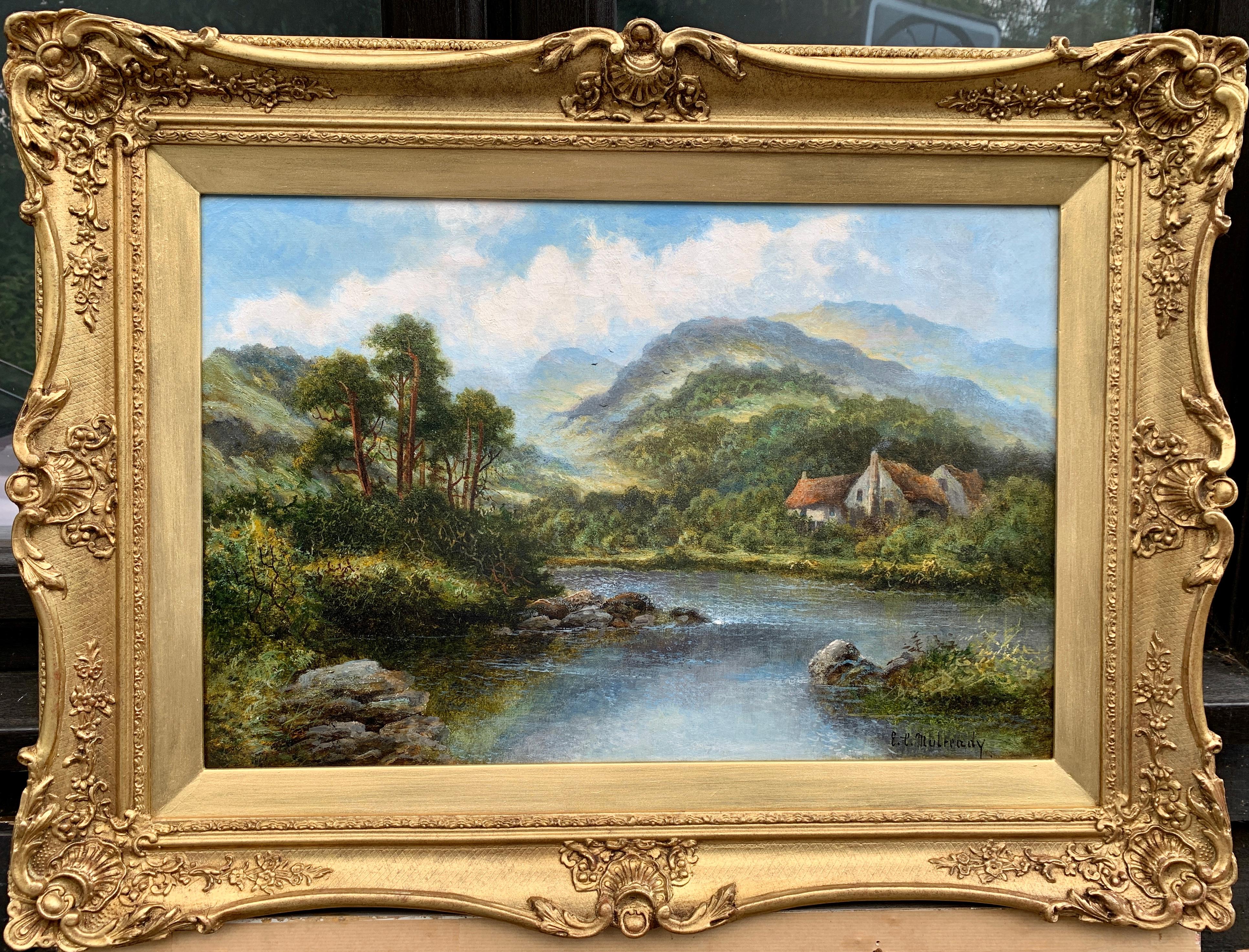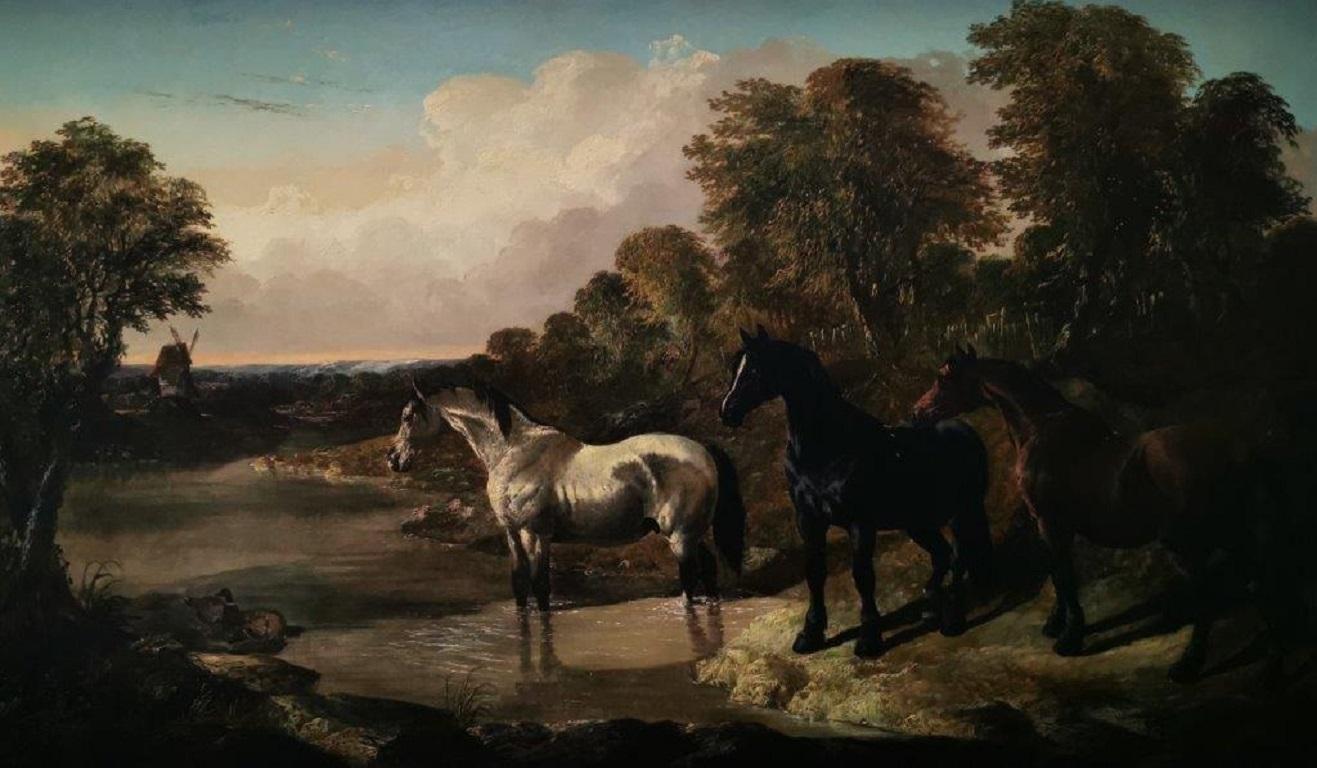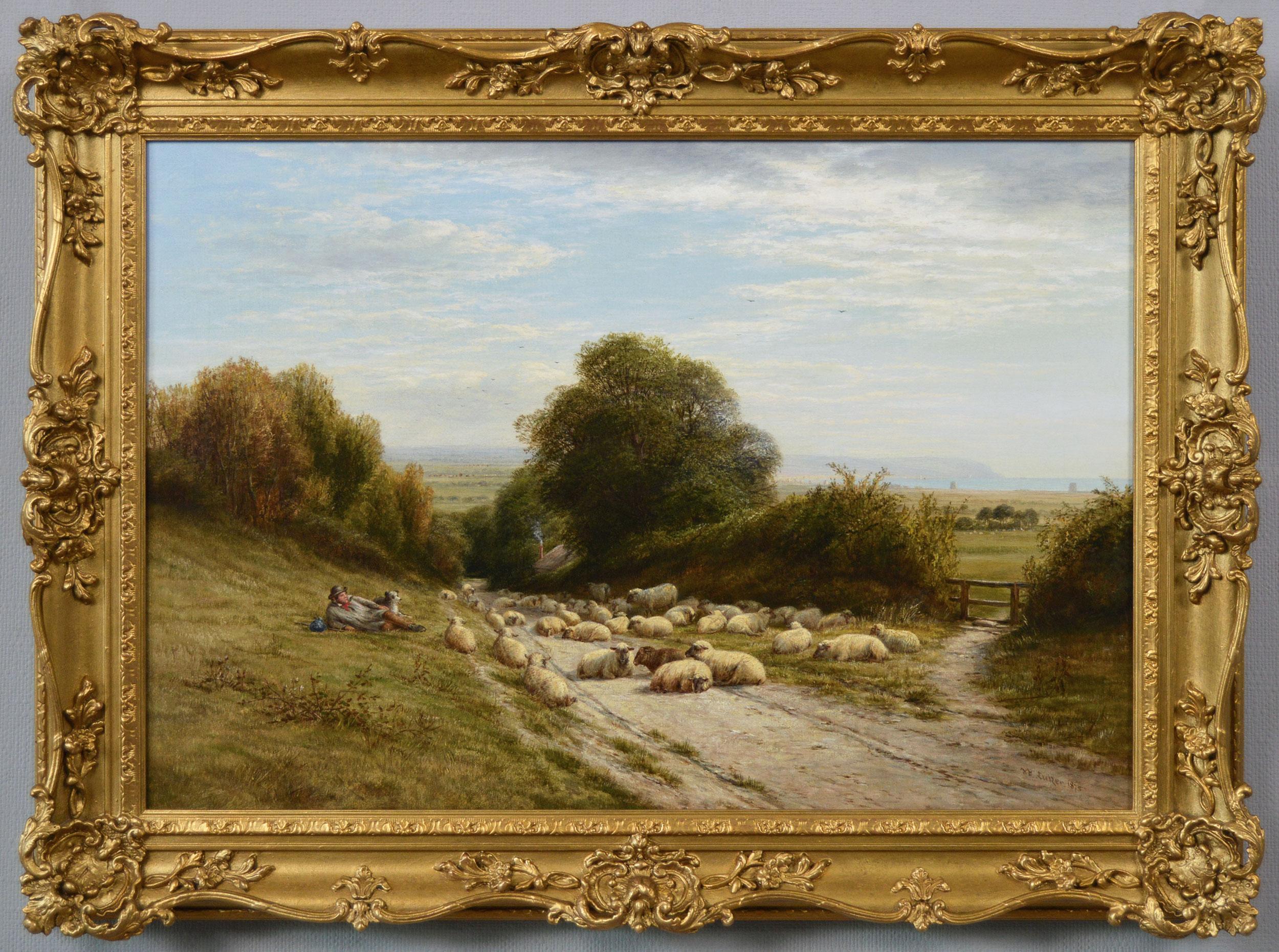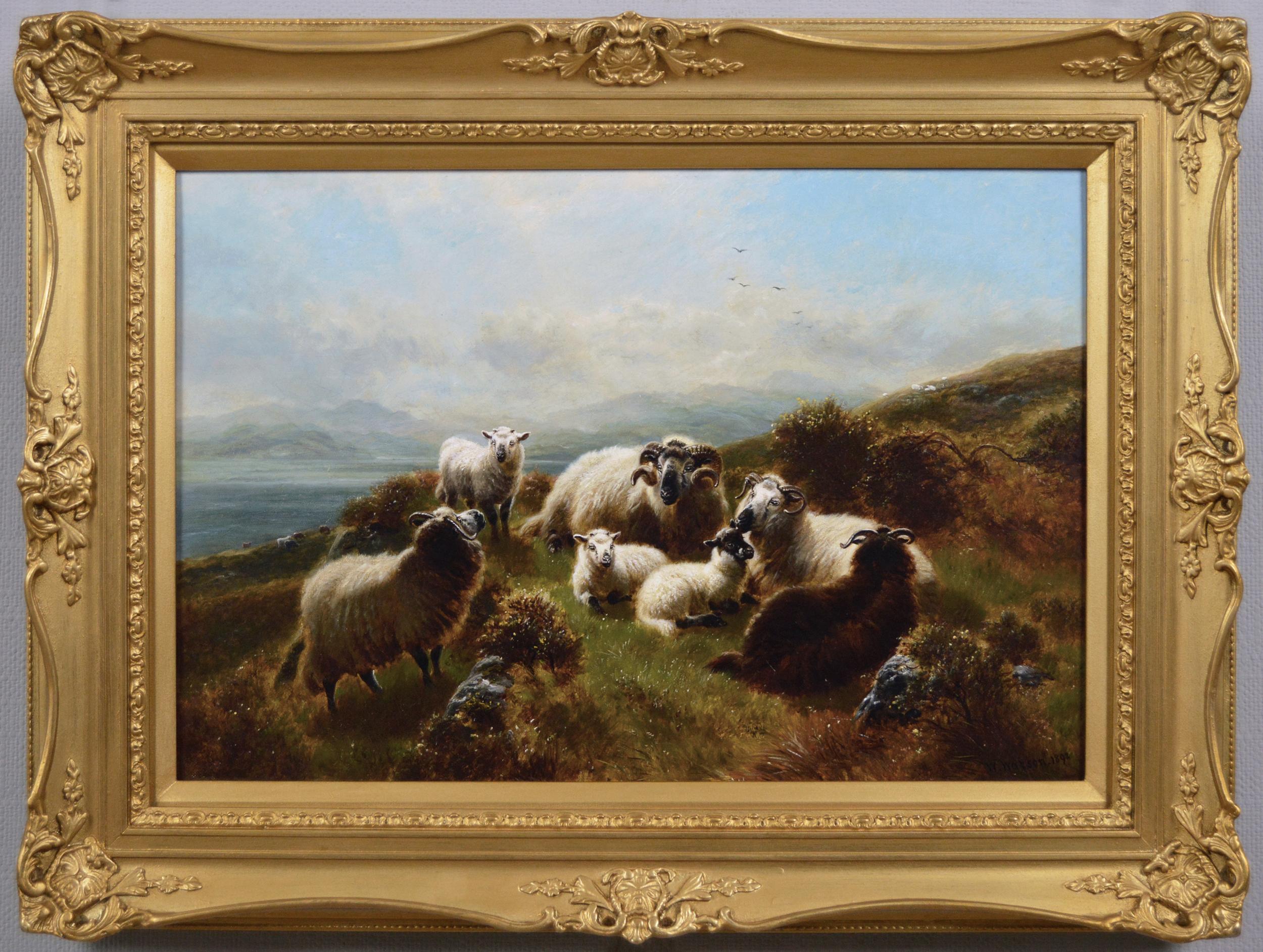Items Similar to 19th Century horse portrait oil painting of a champion Shire mare
Want more images or videos?
Request additional images or videos from the seller
1 of 14
Henry Frederick Lucas Lucas19th Century horse portrait oil painting of a champion Shire mare1893
1893
About the Item
Henry Frederick Lucas Lucas
British, (1848 1943)
Rokeby Fuchsia
Oil on canvas, signed & dated (18)93, further signed & inscribed verso
Image size: 19.5 inches x 25.5 inches
Size including frame: 25.5 inches x 31.5 inches
A wonderful painting of a dappled grey champion Shire mare named Rokeby Fuchsia in a stable, by Henry Frederick Lucas Lucas. Rokeby Fuchsia was a famous champion Shire mare foaled in 1887, by Lincolnshire Boy (sire) and Lady Grey (dam) by Noble Devonshire. The breeders were WH & J Spalton of Derby. The mare was originally called Bowbridge Fuchsia and owned by Mr. J Camden of Aston Magna in Warwickshire, who first began showing her.
In 1891, she was sold to Mr John Parnell of Rugby and her name was changed to Rokeby Fuchsia. Parnell owned a number of show horses and under his ownership she began winning a number of championships and key prizes. At the Essex Agricultural Show of 1892 she won 1st prize in the Shire Mare class, the championship cup and the Shire Horse Society’s Gold Medal for the best mare. In February 1893, she won first prize and took both the Challenge cup and the Championship cup at the annual Shire Horse Show at Islington. In the same year she won first prizes at the Royal Agricultural Show, the Leicestershire agricultural show and Warwickshire Agricultural show. In 1894, she again took the first prize, Challenge cup and Championship cup at the Shire Horse Show. She then went on to win the Champion prize for Best Shire Mare at the Royal Agricultural Show of June 1894.
Her success undoubtedly prompted her owner, John Parnell to commission this portrait from Lucas Lucas who also lived in Rugby. An illustration of the painting was published in the Land and Water magazine of March, 1894. It was also referred to in an article about Rokeby Fuchsia by the Rugby Advertiser of 10 March, 1894 which described it as “an excellent painting”. A Photograph of the mare titled “Mr. John Parnell’s Rokeby Fuchsia” later appeared in the 1897 book ‘Points of the Horse’ by M. Horace Hayes, facing page 254.
Henry Frederick Lucas was born on 24 March, 1848 in Louth, Lincolnshire, the son of St. John Wells Lucas, a surgeon and Louisa Lucas née Bazalgette. His mother died when he was young and by 1871 the family had moved to Withington in Lancashire where Lucas became an architect’s pupil, helping to produce drawings. At some point in his late 20’s, he decided to become an artist and although little is known about his education, given the quality of his work he most likely studied art and animal anatomy. It is unclear why he started signing his works as Henry Frederick Lucas-Lucas, but this may well have been to distinguish himself from other artists.
He married Sarah Blanche Mordacque on 26 June, 1877 at St Peter Port, Guernsey and they moved to Rugby shortly afterwards, living at Clifton Road. By 1879, Lucas had established himself as an animal artist and was living in North Street. Their only child St John Welles Lucas Lucas (1879-1934) later attended Oxford and became a poet, publishing works from 1904.
Lucas specialised in sporting paintings usually featuring horses or dogs. Many of his works were portraits of racehorses, polo ponies and hunters, but he also painted hunting scenes, including the Pytchley Hunt and polo matches. His paintings were popular within the sporting community and gained him many commissions, including those from patrons such Earl Beatty and Sir Humphrey de Trafford. Many polo ponies and hunters that were owned by them were painted by Lucas. Some of the polo ponies that played in the Westchester Cup matches were also painted by him including Charmer, owned by Walter Jones and Blue Sleeve owned by Pat Nichols in 1909. Some of his paintings were also published by Fores Sporting Prints including perhaps his most famous work ‘Putting in the Terrier. Although he tended to work mostly on commissions, he is known to have exhibited at the Royal Birmingham Society of Artists between 1885 and 1887.
Lucas married Kathleen Liffie Beatson in October of 1890 after the death of his first wife. The couple had 5 children together and lived at Hillmorton Road, Rugby. He continued to work as an artist from his base in Rugby, following sporting events around the country. After the death of his second wife in 1935, he spent his remaining years living at Bilton Hill, Rugby and was still known to be active as an artist as late as 1939. He died in Northampton in 1943 at the age of 95. Examples of his work are held by the National Horseracing Museum, National Trust, Newport Museum, Walker Art Gallery, Liverpool and Museum of the Dog, New York.
Presentation: The painting is housed in a new, English made gilt frame which is in excellent condition.
Condition: As with all of our original antique oil paintings, this work is offered in ready to hang gallery condition, having been professionally cleaned, restored and revarnished.
© Benton Fine Art
- Creator:Henry Frederick Lucas Lucas (1848 - 1943, British)
- Creation Year:1893
- Dimensions:Height: 25.5 in (64.77 cm)Width: 31.5 in (80.01 cm)Depth: 2.5 in (6.35 cm)
- Medium:
- Movement & Style:
- Period:
- Condition:
- Gallery Location:Nr Broadway, GB
- Reference Number:1stDibs: LU156212656112
About the Seller
4.9
Platinum Seller
These expertly vetted sellers are 1stDibs' most experienced sellers and are rated highest by our customers.
Established in 1972
1stDibs seller since 2015
272 sales on 1stDibs
Typical response time: <1 hour
Associations
The British Antique Dealers' AssociationLAPADA - The Association of Arts & Antiques DealersInternational Confederation of Art and Antique Dealers' Associations
- ShippingRetrieving quote...Ships From: Nr Broadway, United Kingdom
- Return PolicyA return for this item may be initiated within 3 days of delivery.
More From This SellerView All
- 19th Century landscape oil painting of sheep in a Sussex laneBy William Luker Sr.Located in Nr Broadway, WorcestershireWilliam Luker Snr British, (1828-1905) Sheep in a Sussex Lane with Pevensey Bay in the distance Oil on canvas, signed & dated 1875 Image size: 17.25 inches x 25.25 inches Size including frame: 23.25 inches x 31.25 inches A tranquil landscape scene of a shepherd and his flock resting in a lane near Pevensey Bay, Sussex by William Luker. The ruins of Pevensey Castle can be seen in the distance with the sea beyond. William Luker Snr was born in 1828 at Faringdon, Berkshire to William and Jane Luker (née Charlwood). His father was a plumber and glazier by trade and the family lived at London Street in Faringdon. Little is known about his early education and it is believed for the most part he was self -taught. However, given the quality of his work and the fact that his family were able to keep a servant, he may well have received some artistic tuition. By the early 1850’s, he had begun earning a living as an artist by advertising in local directories, earning commissions from local landowners. He made his debut at the Royal Society of British Artists in 1851 and was a prolific exhibitor there for over 40 years. He began exhibiting at the Royal Academy in 1852 and also exhibited at the British Institution. He married the artist Ada Augusta Margetts (1839-1930) on 27 October 1864. Their eldest son William Luker Jnr (1867-1951) also became a well-known artist. The couple soon moved to London where they lived at 22 Gloucester Terrace, Campden Hill from where they both exhibited. From 1867, they lived at 15 Sheffield Terrace in Kensington until 1874 when they moved for the final time to 22 Notting Hill Square, later renamed Campden Hill Square in 1893. He died at Campden Hill-square on 28 February, 1905. Luker specialised in landscapes featuring animals such as sheep and cattle, horses and deer. He travelled around visiting areas such as Sussex, Buckinghamshire, Kent, Wales and the Highlands. However, he also made trips to Egypt and Libya producing a series of Oriental scenes in the early 1860’s. His works show a great attention to detail and his use of a lighter palette gives his subjects a luminous quality that instantly attracts the viewer. Examples of his paintings are held by the Atkinson Art Gallery, National Library of Wales, Newstead Abbey...Category
19th Century Victorian Animal Paintings
MaterialsCanvas, Oil
- 19th Century Highland landscape oil painting of sheep near Loch AweLocated in Nr Broadway, WorcestershireWilliam Watson Jnr British, (1847-1921) On the Mountains, Loch Awe Oil on canvas, signed & dated 1892, further inscribed verso Image size: 12.5 inches x 18.5 inches Size including frame: 18.5 inches x 24.5 inches A wonderful painting of Highland sheep resting near Loch Awe by William Watson Jnr. Loch Awe is located in Argyll and Bute in the Scottish Highlands and this scene is taken from the mountain side overlooking the loch. William Watson was born in Islington in 1847, the son of the London miniature painter William John Watson (1810-1871) and his wife Caroline (née Butcher). His brothers Charles Watson (1837-1900) and Robert Watson (1855-1921) were also artists. His father seems to have travelled around and after spending time in Brighton, the family moved to Bransford Road in Worcester during the early part of the 1860’s. As well as being taught by his father, Watson received his early training in the studio of Sir Francis Grant PRA (1803-1878). He later became a pupil of Sir Edwin Henry Landseer RA (1802-1873) and Rosa Bonheur (1822–1899). Both Landseer and Bonheur had a great influence on his work and he began specialising in scenes of cattle and sheep. By 1866 he had become a full time artist and began exhibiting at the Royal Society of British Artists. Perhaps to take advantage of the inspiring scenery, Watson moved to Birkenhead, Cheshire where in 1871 he met and married Eleanor Davies who was from Caernarvonshire. Four of their children Sidney Watson (1881-1931), Caroline Ellen...Category
19th Century Victorian Animal Paintings
MaterialsCanvas, Oil
- 19th Century landscape oil painting of cattle near Canterbury CathedralBy William Sidney CooperLocated in Nr Broadway, WorcestershireWilliam Sidney Cooper British, (1854-1927) Cattle Watering near Canterbury Cathedral Oil on canvas, signed & dated 1923 Image size: 15.5 inches x ...Category
Early 20th Century Victorian Animal Paintings
MaterialsCanvas, Oil
- 19th Century landscape oil painting of the river Lledr near Bettws-y-coedBy Henry H. ParkerLocated in Nr Broadway, WorcestershireHenry H Parker British, (1858-1930) The River Lledr, Bettws-y-coed Oil on canvas, signed, further signed & inscribed verso Image size: 19.5 inches x 29.5 inc...Category
19th Century Victorian Landscape Paintings
MaterialsCanvas, Oil
- 19th Century landscape oil painting of sheep near a five bar gateBy Charles Jones (b.1836)Located in Nr Broadway, WorcestershireCharles Jones British, (1836-1892) Sheep by a Five Bar Gate Oil on panel, signed with monogram & dated (18)90, further inscribed verso Image size: 11.5 inches x 19 inches Size includ...Category
19th Century Victorian Animal Paintings
MaterialsCanvas, Oil
- 19th Century Scottish landscape oil painting of Highland sheep at Glen CoeBy William WatsonLocated in Nr Broadway, WorcestershireWilliam Watson Jnr British, (1847-1921) Morning, Head of Glen Coe Oil on canvas, signed & dated 1897, further inscribed verso Image size: 12.5 inches x 18.5 inches Size including frame: 19.75 inches x 25.75 inches A superb Scottish landscape painting of Highland Sheep at the head of Glen Coe by William Watson. The sheep and their lambs are depicted grazing in the morning light with the dramatic mountains beyond. Glen Coe is a valley located in the Highlands to the North of the county of Argyll and close to the province of Lochaber. The area, which became infamous for the Massacre of Glencoe is one of Scotland’s most scenic Highland glens. William Watson was born in Islington in 1847, the son of the London miniature painter William John Watson (1810-1871) and his wife Caroline (née Butcher). His brothers Charles Watson (1837-1900) and Robert Watson (1855-1921) were also artists. His father seems to have travelled around and after spending time in Brighton, the family moved to Bransford Road in Worcester during the early part of the 1860’s. As well as being taught by his father, Watson received his early training in the studio of Sir Francis Grant PRA (1803-1878). He later became a pupil of Sir Edwin Henry Landseer RA (1802-1873) and Rosa Bonheur (1822–1899). Both Landseer and Bonheur had a great influence on his work and he began specialising in scenes of cattle and sheep. By 1866 he had become a full time artist and began exhibiting at the Royal Society of British Artists. Perhaps to take advantage of the inspiring scenery, Watson moved to Birkenhead, Cheshire where in 1871 he met and married Eleanor Davies who was from Caernarvonshire. Four of their children Sidney Watson (1881-1931), Caroline Ellen Watson (1871-1947), William Robert Charles Watson (1873-1928) and Walter James Watson...Category
19th Century Victorian Animal Paintings
MaterialsCanvas, Oil
You May Also Like
- 19th century Scottish Highland lock landscape with Highland Cattle drinkingLocated in Woodbury, CTLate 19th century Scottish Highland Lock landscape, with Cattle watering E.Mulready was almost certainly a pseudo name for William Langley a well known English painter of landscapes...Category
1890s Victorian Landscape Paintings
MaterialsOil, Canvas
- 19th century Scottish Highland lock landscape with Highland Cattle drinkingLocated in Woodbury, CTLate 19th century Scottish Highland Lock landscape, with Cattle watering E.Mulready was almost certainly a pseudo name for William Langley a well known English painter of landscapes...Category
1890s Victorian Landscape Paintings
MaterialsOil, Canvas
- "A River Landscape with Wild Horses", Victorian original, oil on canvasBy John Frederick Herring JrLocated in Nutfield, SurreyThis is an original unique oil painting by the artist. Born into an artistic family in Doncaster, England during 1820. Best known for his equine art, of the same character as those of the elder Herring, including "The Home Farm," "The Homestead," "The Farm-Yard," etc.John F. Herring, Jr. was born in Doncaster, South Yorkshire c.1820, to the well-known 19th-century artist John Frederick Herring, Sr. (1795-1865), who at the time, was considered one of England's great Sporting and Equestrian artists, patronized by the English aristocracy. The father's mastery of the brush, and popularity with the nobility, served his son, Herring, Jr., well. Early on, John, Jr. was exposed to fine painting and wealthy patrons. Recent reference books state that Herring, Sr.'s first child was named "John Frederick Herring, Jr." and was born on June 21, 1815. John Herring, Jr. developed a love for painting, a passion also shared by his brothers Charles and Benjamin. Three of the four brothers became artists, painting in the same style as their father, often collaborating on a single painting. In the years after 1836, Herring, Sr., feeling threatened by the teenage John Herring, Jr.'s ability and growing popularity, began incorporating the tag "SR" at the end of his signature. John Herring, Jr. continued painting in the tradition of his father, the sporting and animal pictures...Category
19th Century Victorian Landscape Paintings
MaterialsCanvas, Oil
- A Racehorse with Owner and Jockey, 19th Century Equine Oil PaintingLocated in London, GBOil on canvas Image size: 25 1/2 x 19 1/2 inches (40 x 50 cm) 19th century gilt pierced frame This is a wonderful scene featuring a dark bay racehorses mounted by its jockey. The pa...Category
Mid-19th Century Victorian Animal Paintings
MaterialsOil, Canvas
- Antique 19th century English portrait two Bull Dogs in a yard.By John Frederick Herring Sr.Located in Woodbury, CTA wonderful 19th century portrait of two Bull dogs in a barnyard. Artist Bio: Herring was born on 12 September 1795 in Blackfriars, London, the eldest of nine children of Benjamin Herring...Category
1840s Victorian Animal Paintings
MaterialsCanvas, Oil
- English Victorian 19th century portrait of a brown and white Spaniel dogBy George EarlLocated in Woodbury, CTGeorge Earl was a painter, primarily of sporting dogs and other animals. He was also the father of Maud Earl and Percy Earl, and the brother of Thomas Earl, all three of whom were al...Category
1850s Victorian Animal Paintings
MaterialsCanvas, Oil
Recently Viewed
View AllMore Ways To Browse
Luca Luca
19th Century Horse
1893 Painting
19th Century Paintings Of New York
Paintings Of Oxford
Horse Oil Paintings With Frame
19th Century Street Painting
Painting Of Mother And Son
19th Century Art Horses
19th Century Oil Painting Of Family
Blue Oil Antique Oil Painting
19th Century Paintings Of Children
Brown Oil Painting Horse
Original Horse Oil Painting
Painting Prize Winning
Antique Animal Portrait
Original Horse Art Oil
19th Century Oil Paintings Of Animals





